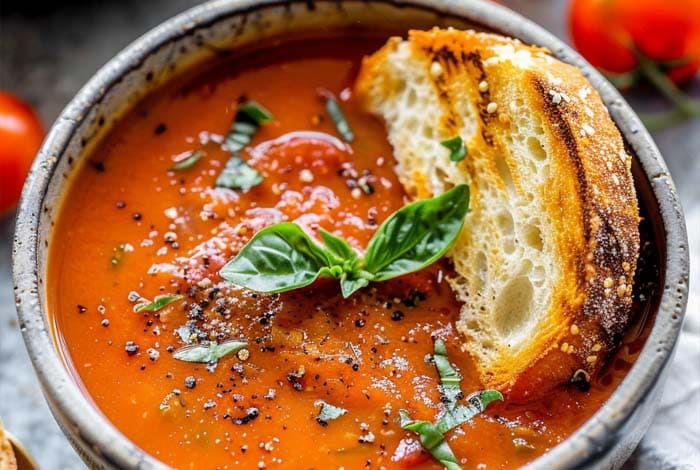Introduction to Tomato Soup
Tomato soup embodies the essence of comfort food with its rich, velvety texture and deep, tangy flavor. This beloved dish has a humble yet complex profile, making it a staple in various cuisines around the world. Its history is as rich as its taste, tracing back to the introduction of the tomato from the Americas to Europe, where it transformed from an ornamental curiosity into a culinary star. The evolution of tomato soup mirrors the journey of the tomato itself, from its initial mistrust to becoming a cherished ingredient in kitchens globally.
Brief History of Tomato Soup
The tomato’s journey from the New World to Europe in the 16th century marked the beginning of the tomato soup we know today. Initially met with suspicion, tomatoes eventually gained popularity in the Mediterranean diet by the 17th century. The first recorded tomato soup recipes appeared in cookbooks by the late 18th century. Canned tomato soup, introduced in the late 19th century by Joseph Campbell, revolutionized the dish, making it a household staple and setting the stage for the myriad variations we enjoy today.
Why It’s a Beloved Dish Worldwide
Tomato soup’s global appeal lies in its comforting simplicity and versatility. It caters to a wide range of taste preferences, dietary needs, and culinary traditions, making it a universal favorite. Its ability to be both a humble home-cooked meal and a sophisticated dish allows it to cross cultural boundaries effortlessly. The warmth and comfort it provides, alongside its nutritional benefits, make it a go-to choice for families and chefs alike. Whether enjoyed on a cold winter’s day or as a light summer meal, tomato soup holds a special place in the hearts of people around the world.
The Basics of Tomato Soup
Tomato soup, a quintessential comfort food, begins with a few basic ingredients that combine to create its distinctive, beloved flavor. The classic tomato soup recipe hinges on ripe, juicy tomatoes that form the base, providing both the iconic color and the rich, tangy taste. Onions and garlic are sautéed in olive oil or butter to add depth and aroma, while vegetable or chicken broth gives the soup its liquid consistency. Herbs such as basil or oregano are often incorporated for their fragrance and flavor, and a pinch of salt and pepper is added to enhance the overall taste profile.
Common Variations
- With Basil: Fresh or dried basil leaves add a sweet, herbal freshness, making it a popular variant known as tomato basil soup.
- Creamy Version: Incorporating cream or milk transforms the soup into a richer, velvety concoction that’s both hearty and luxurious.
- Spicy Tomato Soup: For those who prefer a bit of heat, adding chili flakes, jalapeños, or hot sauce introduces a spicy kick that complements the tomato’s tanginess.
These variations demonstrate the versatility of tomato soup, allowing it to adapt to different culinary preferences and seasons. From the creamy comfort of a winter meal to the light zestiness of a summer appetizer, tomato soup can be customized in numerous delightful ways.
Nutritional Information
Tomatoes, the star ingredient of tomato soup, are renowned for their health benefits. They are a rich source of vitamins C and K, potassium, folate, and antioxidants, including lycopene, which has been linked to reduced risks of heart disease and cancer. A standard serving of tomato soup can provide a good dose of these essential nutrients, contributing to a healthy diet.
Moreover, tomato soup is inherently low in calories and fat, making it an excellent choice for those looking to maintain a balanced diet. However, the nutritional profile can vary based on the recipe—creamy versions will be higher in calories and fat, while spicy or basil-infused variations might offer more vitamins and minerals. Regardless of the variation, tomato soup remains a nutritious option that can fit into a variety of dietary preferences, providing both health benefits and comforting satisfaction.
Preparation Techniques
Making classic tomato soup is an art that combines simplicity with a touch of culinary finesse. Here’s a step-by-step guide to crafting this comforting dish:
- Start with the Base: Heat a tablespoon of olive oil or unsalted butter in a large pot over medium heat. Add one finely chopped onion and two minced garlic cloves, sautéing until they are soft and translucent.
- Add Tomatoes: Incorporate about 2 pounds of fresh, ripe tomatoes (peeled and chopped) into the pot. For a richer flavor, you can also use canned tomatoes.
- Season: Sprinkle salt and pepper to taste, adding a teaspoon of sugar to balance the acidity of the tomatoes. If available, a handful of fresh basil leaves or a teaspoon of dried basil can be added for an aromatic touch.
- Pour in Broth: Add 4 cups of vegetable or chicken broth, bringing the mixture to a simmer. Let it cook for 20-30 minutes, allowing the flavors to meld together.
- Blend: Use an immersion blender to puree the soup directly in the pot, or carefully transfer it to a blender to achieve a smooth consistency.
- Finish with Cream (Optional): For a creamy texture, stir in a half cup of heavy cream or full-fat coconut milk after blending.
- Adjust Seasonings: Taste and adjust for salt, pepper, and herbs, ensuring the soup meets your flavor preferences.
Tips for Perfect Consistency and Flavor
- Roasting Tomatoes: For a deeper flavor, roast the tomatoes in the oven with olive oil and garlic before adding them to the pot.
- Thickness: Control the soup’s thickness by adjusting the amount of broth. For a thicker soup, reduce the broth; for a thinner consistency, add more.
- Seasonal Herbs: Don’t hesitate to experiment with different herbs like thyme or oregano, depending on the season or your palate.
Creative Twists on Traditional Recipes
Personalizing your tomato soup allows you to adapt this classic dish to fit any occasion or taste preference.
Incorporating International Flavors
- Italian-Inspired: Add a touch of pesto sauce and garnish with shaved Parmesan cheese for an Italian twist.
- Mexican-Style: Mix in diced jalapeños, corn, and black beans, topping it off with tortilla strips and avocado for a Mexican flair.
- Indian Fusion: Spice it up with curry powder, cumin, and finish with coconut milk for an Indian-inspired version.
Personal Touches
- Veggie Boost: Enhance the nutritional value by adding carrots, red peppers, or spinach. These not only contribute to the flavor but also add vibrant colors.
- Protein-Packed: For a more filling option, incorporate cooked quinoa, lentils, or shredded chicken into the soup after blending.
- Garnish Creatively: Top your soup with homemade croutons, a dollop of sour cream, fresh herbs, or roasted seeds for added texture and flavor.
By experimenting with different ingredients and flavors, you can transform the classic tomato soup into a unique dish that reflects your culinary creativity and caters to a wide range of dietary preferences and cultural tastes.
Serving and Pairing Suggestions
Serving Suggestions
Tomato soup, with its rich and comforting flavor, offers a canvas for an array of garnishes and side dishes that can elevate it from a simple dish to an elegant meal.
Ideal Garnishes:
- A swirl of cream or a dollop of sour cream can add richness.
- Fresh herbs like basil, thyme, or chives bring a pop of color and freshness.
- Croutons, a sprinkle of grated Parmesan, or toasted seeds (pumpkin or sunflower) introduce texture.
Recommended Side Dishes:
- Grilled cheese sandwiches are a classic pairing, offering a crispy, melty contrast to the soup’s smoothness.
- A side salad with a light vinaigrette complements the soup’s richness without overpowering it.
- Garlic bread or a crusty baguette serves as the perfect vehicle for dipping and soaking up the soup.
Pairing with Drinks
The right drink can complement the flavors of tomato soup, rounding out the dining experience.
Best Drinks:
- For wine lovers, a light-bodied white wine like Sauvignon Blanc or a Chardonnay pairs well, cutting through the richness with its acidity.
- A Pale Ale or a Lager can refresh the palate between spoonfuls with their crispness.
- For a non-alcoholic option, a sparkling water with a squeeze of lemon or an iced herbal tea can be very refreshing.
Frequently Asked Questions
- Can tomato soup be frozen? Yes, tomato soup can be frozen for up to six months. Cool it completely before transferring to freezer-safe containers, leaving some space for expansion. Thaw overnight in the refrigerator before reheating.
- How to thicken tomato soup? To thicken tomato soup, you can add a tablespoon of tomato paste, cook it down to reduce its liquid, or blend in some bread or cooked white rice before pureeing. Each method adds thickness without diluting the flavor.
- Is tomato soup healthy? Tomato soup is indeed healthy, packed with vitamins C and K, potassium, and antioxidants like lycopene. Opting for homemade soup allows control over sodium and cream additions, tailoring it to dietary needs.
- Can I make tomato soup without a blender? Absolutely. For a chunkier version, finely chop the tomatoes and other vegetables. As they cook down, they’ll soften and break apart, creating a rustic, hearty texture that doesn’t require blending.

Classic Creamy Tomato Soup Recipe
Equipment
- Large pot
- Immersion blender or regular blender
- Measuring cups and spoons
Ingredients
- 2 tablespoons olive oil
- 1 medium onion diced
- 2 cloves garlic minced
- 2 pounds fresh tomatoes peeled and chopped, or 1 large can (28 ounces) of whole tomatoes with juice
- 4 cups vegetable or chicken broth
- 1/2 cup heavy cream
- Salt and pepper to taste
- 1 teaspoon sugar optional
- Fresh basil leaves for garnish
Instructions
- Prepare the Base: In a large pot, heat the olive oil over medium heat. Add the onion and garlic, sautéing until soft and translucent.
- Cook the Tomatoes: Add the tomatoes, including juice if using canned. Cook for a few minutes until they begin to soften.
- Add Broth and Simmer: Pour in the broth and bring the mixture to a simmer. Let cook for 25 minutes, allowing the flavors to meld.
- Blend the Soup: Use an immersion blender to puree the soup in the pot until smooth. Alternatively, carefully transfer the soup to a blender and puree.
- Stir in Cream: Return the soup to the pot if needed and stir in the heavy cream. Heat through, then season with salt, pepper, and sugar if desired.
- Serve: Ladle the soup into bowls, garnish with fresh basil, and serve warm.
Notes
- For a lighter version, substitute the heavy cream with full-fat coconut milk or a lighter cream.
- The soup can be stored in the refrigerator for up to 3 days or frozen for up to 3 months.
- For a vegan option, omit the cream or use a plant-based alternative, and ensure the broth is vegetable-based.

